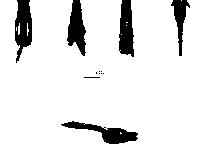Genevieve LeMoine spent a good chunk of this past summer trying to solve a thousand- year-old Arctic mystery, and getting there involved a multistage journey to the northern edge of the world. “We took a military flight from McGuire Air Force Base in New Jersey to Thule in Greenland,” said LeMoine, curator of the Peary MacMillan Arctic Museum. “From Thule, we chartered a helicopter to the field site at Etah, now known by its Inuit name of Iita, on the north west corner of Greenland, a site of historic importance.”

Genevieve LeMoine
LeMoine was joined by Lara Bluhm ’17, and colleagues from UC Davis, University of Greenland, and the Greenland National Museum and Archives. They were looking for evidence regarding the dates of the Dorset people, who inhabited the region between about 1,800 and 800 years ago, and the Thule people, who arrived there about 800 years ago and are the ancestors of the modern Inuit. “The Dorsets are the last of the earliest known occupiers of this part of the world,” she said, “and they were succeeded by the Thule, who were quite a different culture.” The mystery LeMoine and her team are trying to solve is whether the two groups overlapped, and if so, what interaction they had.
On a practical level there was an urgency about this trip, said LeMoine, brought about by the fact that the landscape is altering rapidly due to climate change. “I was last here for field work in 2006, and there have been really dramatic and noticeable changes in that time.” LeMoine said she witnessed a massive reduction in the volume of sea ice and a much greater amount of lush, green vegetation. “The site is on the coast, so this decrease in sea ice appears to be exposing the site to more waves and erosion, meaning there was a definite urgency to collect as many artifacts as we could during the six week trip, which was funded by a grant from the National Science Foundation.” This loss of sea ice has serious implications, said LeMoine, for many of the region’s indigenous people, who have long relied on the sea ice as a platform for hunting. “The changing climate is really restricting many of them, and some hunters are turning to fishing to make a living.”
View slideshow
As for the archaeological research, LeMoine and her collaborators plan to publish a paper sometime in 2017 and start giving presentations in the spring. “It’s too early to draw any conclusions, because we’re waiting for all the samples we collected to be analyzed.” But based on earlier research there is already some suggestion that the Thule people learned some things from the Dorset, she added. “”There are, for example some styles of harpoon heads excavated from Thule settlements that suggested they at least copied from the Dorset.” But whether they copied from artifacts they found lying on the ground, or whether they learned how to make them from the Dorset themselves, is not yet known, she added. “It’s really exciting to be trying to solve this mystery.”
The Dorset vanished without trace, said LeMoine, and the Thule migrated into the region between 800 and 900 years ago. According to recent genetic studies, she’s said, the two people did not interbreed, “although these studies are not entirely conclusive, because there are not a lot of Dorset remains to study.” The Thule and the Dorset peoples also had quite different material cultures. “One of the things that alerted us to the presence of Dorset families at the site was the discovery of flaked stone tools, something the Thule didn’t really make: they tended to use ground stone tools. Both of them used metal tools. On this trip we also found a number of beautiful, little ivory carvings, which the later Dorset people are well known for making. Despite their cultural differences,” she added, “these two people used the exact same suite of natural resources to survive, which is fascinating.”
While she was in Greenland, LeMoine also broke new ground in the communications field, posting live updates to her followers on social media. “I’ve been going to Greenland since 1986 and this was the firs time I’ve been able to do anything like that. We used a device made by Delorme called an InReach which enabled me to tweet and post to Facebook.” It’s quite a contrast, she noted, to the unsuccessful attempts at radio contact made by Donald MacMillan during his infamous Crocker Land expedition one hundred years earlier.





